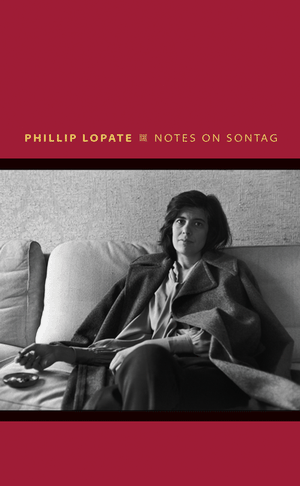
Notes on Sontag (Writers on Writers)
by Phillip Lopate
Phillip Lopate remembers his first encounter with Susan Sontag.
Sontag was already a celebrity in the early 1960s, sometimes referred to as “the intellectual’s Natalie Wood,” when Lopate was an undergraduate at Columbia.
With characteristically frank self-analysis, Lopate admits that, “given [his] fragile would-be-writer’s ego,” he had “an aversion to taking courses with charismatic professors,” and so never studied with Sontag. Despite not being her student, and despite her failure to invite him to join her writers’ group (she did invite a select few undergrads), he did ask her to critique a story he had written. She offered him criticism not cloaked in any hint of praise; Lopate left, noting, “she had failed to see that flame of genius in me as I had hoped.”
But Lopate did make it as a writer, and Notes on Sontag is a rigorous analysis of the work of the “dark lady” of American letters. Her work, Lopate concludes, places her in the highest ranks of nonfiction writers, even if it was sometimes uneven, deliberately provocative and thus occasionally clumsy. The slim book is dotted through with interactions between Lopate and his subject, brief collisions between a self-proclaimed “mid-list writer” and one who is “far more famous and celebrated, providing rich occasions for gratitude, resentment, or amusing memoir fodder.”
All of those sentiments make appearances in Notes on Sontag, but primarily, Lopate probes Sontag’s contradictions, the several “literary masks” she wore: the famed essayist who craves recognition for her less effective fiction; the celebrity lauded in life and disparaged in death; the reflective diarist who disdained most first-person writing; the American who admired and mimicked European intellectuals; the brilliant, depressive woman who seemed to identify most closely with brilliant, brooding men.
Primarily, Lopate focuses on the reversals of opinion in Sontag’s work, offering a generous take on why she switched sides on major political and aesthetic issues throughout her career: “She was an enthusiast – a lover, not a skeptic – who needed to fall hard for a position and convince herself it was the only one.” The most telling instance of her passion was her writing about North Vietnam, in which she stretches to identify with and even lionize the Communist government. Years later, she would declare, in her most quotable aphorism, that communism was fascism with a human face. “Part of what makes her essayist voice so exciting and audacious – but also untrustworthy at times – is the violence she does to her own sense of caution and skepticism.”
Her “self-punishing drive to be ‘radical’ at all costs,” even at the cost of keeping her high standard of writing, seems to be behind her calling the “white race” a “cancer,” (which, Lopate notes, she regretted not because it insulted millions but because it made a metaphor of illness). Shock-writing also seems to drive her essay on 9/11- which appeared only weeks after the attacks and ignored the tragedy and focused solely on critiquing the media – and her late, screeching arrival to feminism (though Lopate is rightfully amused by her call for women to renounce giggling).
Though Sontag and Lopate both seem to deny that a person can be truly known – that identity is stable enough to pin – Notes on Sontag does create a portrait of a kind, with insights that alternately make us feel more intimate with or more distant from Sontag, appropriate for any celebrity and more so for one who so cultivated various personas, all whip-smart. One encounter Lopate had with her is particularly revealing of this sensation – of simultaneous intimacy and distance. It’s long after Lopate’s Columbia days, when he had become a professor in Houston and found himself hosting a dinner for Sontag. Lopate reminded Sontag of her old Columbia writing group, to which Lopate had not been invited. Sontag, Lopate writes, “acknowledged, ‘Yes, you were the only one who made it,’ more or less as I hoped she would. Not that it changed anything between us.”
Excerpt: “Tellingly, she wrote in an early diary entry: ‘Alone, alone, alone. A ventriloquist’s dummy without a ventriloquist.’ So all of us have felt at times, but she was able to circumvent the feeling by turning ‘Susan Sontag’ into a starring public role. In playing it, she resisted pledging allegiance to any pre-established identity, be it American, Jew, or avowed sexual preference. (How hard she made it for interviewers to pin down her precise degree of bisexuality!) By not advancing under any colors other than her own, she could take up more solidly a moral platform, and speak out in the way she most preferred, as an independent moralist. Not that she was incapable of following a party line; theatrical in her presentation of self, she was always casting about for new, juicy roles to fill. Sometimes she seems merely, or too manifestly, to be playing out a role….”
Further Reading: Against Interpretation: And Other Essays and Swimming in a Sea of Death: A Son’s Memoir




Send A Letter To the Editors